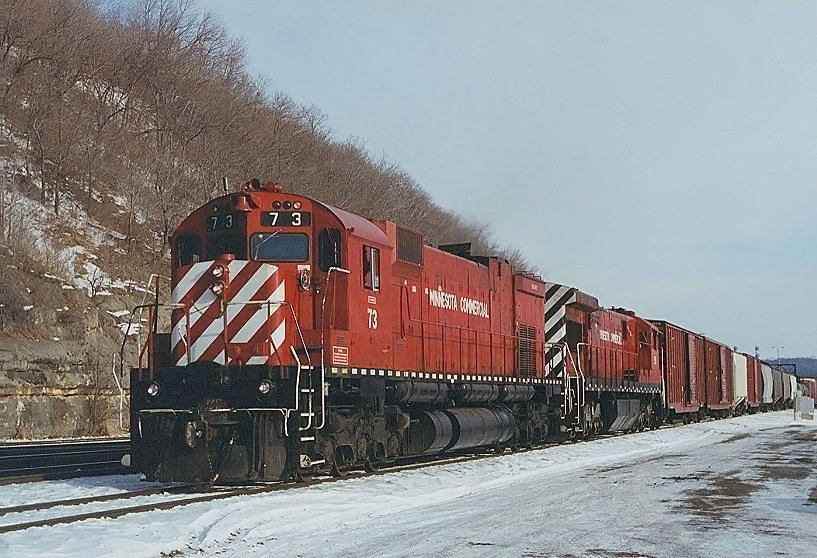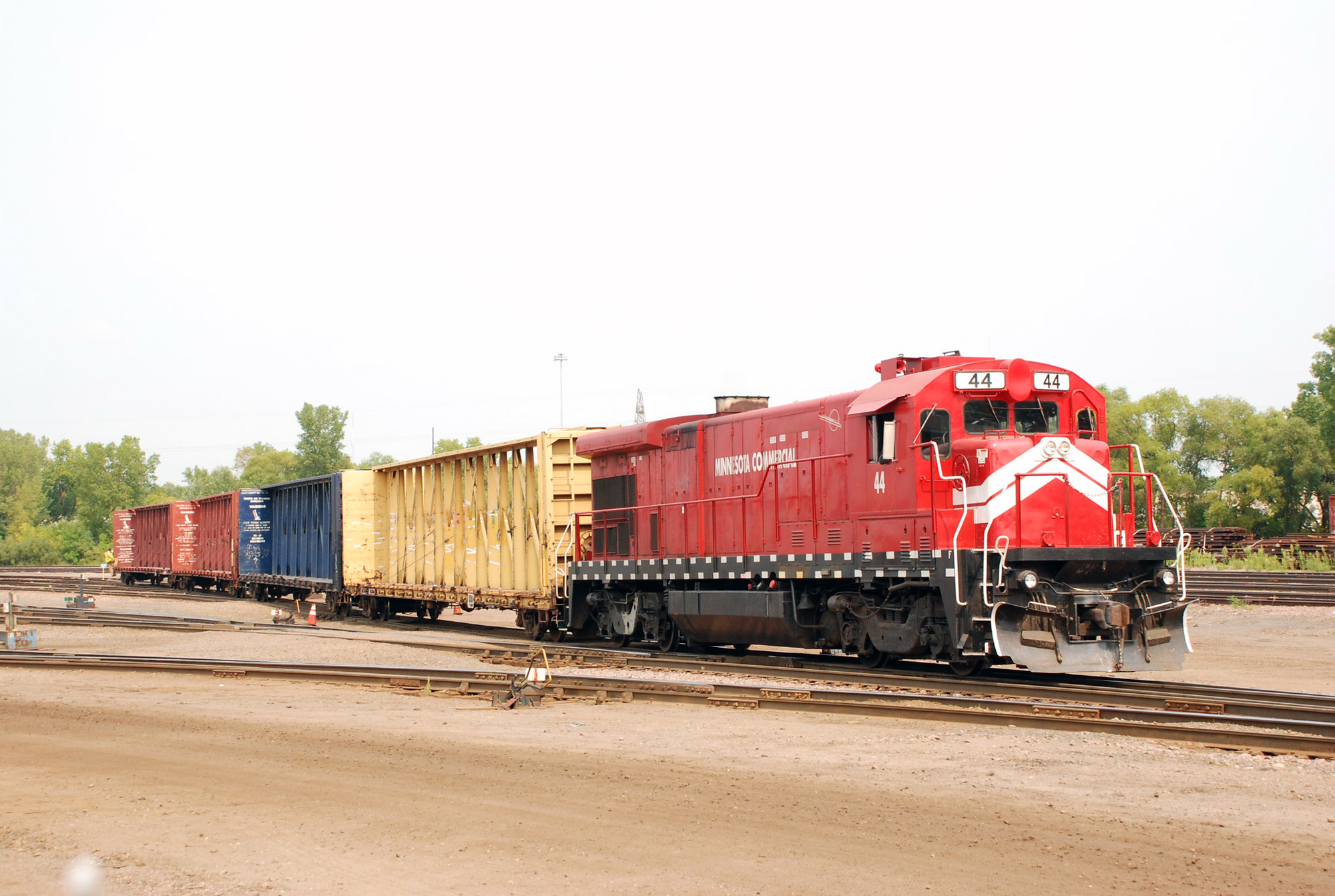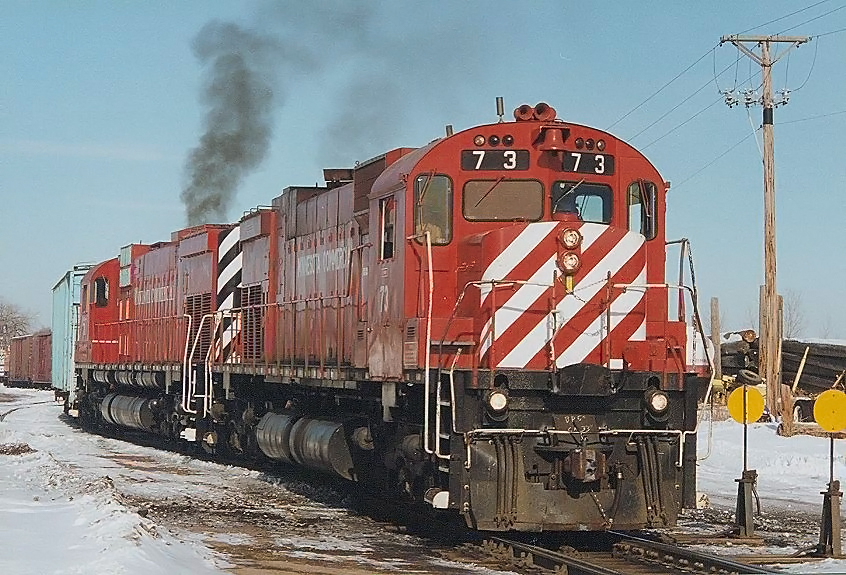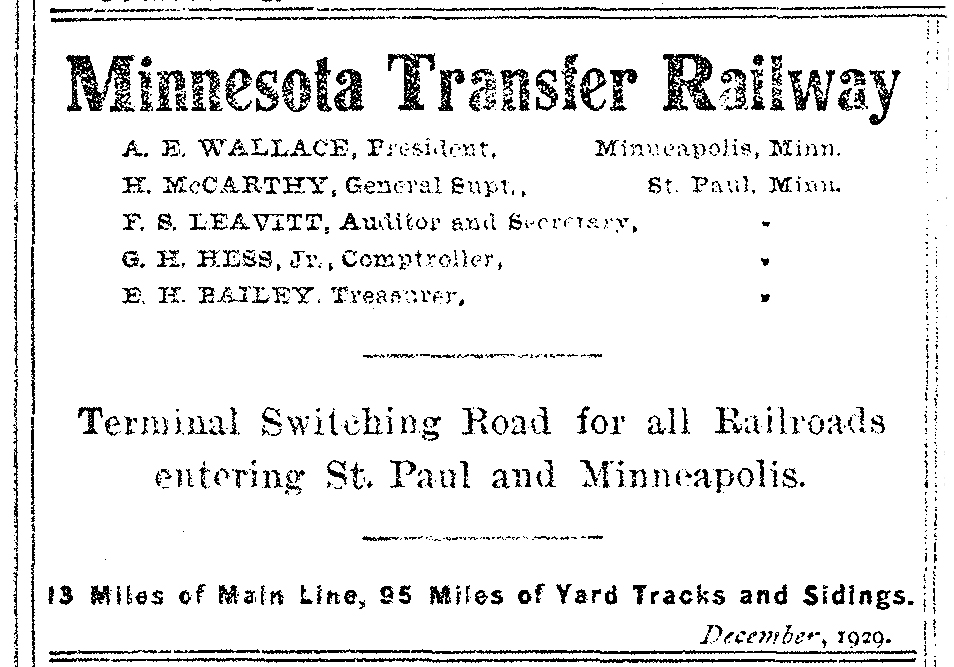Minnesota Commercial Railroad: A Classic Regional Line
Published: August 21, 2024
By: Adam Burns
Railroads have been the backbone of American commerce and industry for more than a century, adapting and evolving to meet the demands of a growing economy.
Among these resilient enterprises, the Minnesota Commercial Railroad (MNNR) stands out as a quintessential example of a regional railroad that has effectively leveraged its niche to carve a unique path in the industry.
The system is well known among enthusiasts for operating a fleet of venerable Alco and MLW products, as well as early GE road-switchers. The company - whose heritage can be traced back to the Minnesota Transfer Railway, the Twin Cities' historic terminal road - has remained independent since its 1987 founding.
This article explores the history, operations, infrastructure, and impact of the Minnesota Commercial Railroad, illuminating the vital role it plays in the Twin Cities region.
 Minnesota Commercial M630 #73 (ex-CP) and SF30C #50 (ex-Santa Fe) are headed west with a transfer run at Hoffman Avenue in St. Paul on January 29, 2000. Doug Kroll photo.
Minnesota Commercial M630 #73 (ex-CP) and SF30C #50 (ex-Santa Fe) are headed west with a transfer run at Hoffman Avenue in St. Paul on January 29, 2000. Doug Kroll photo.Heritage
The Minnesota Commercial Railroad is a relatively young player in the rich tapestry of American rail history, established in 1987. Arising from the remnants of various defunct and consolidated rail lines, MNNR was formed to specifically serve the freight needs of the Minneapolis-Saint Paul metropolitan area.
The railroad's inception was directly tied to preserving localized rail service in an era when many larger carriers were abandoning less profitable routes.
The MNNR's heritage dates back to the Minnesota Transfer Railway, a terminal line historically owned by the Chicago, Burlington & Quincy; Chicago Great Western; Milwaukee Road; Rock Island; Chicago, St. Paul, Minneapolis & Omaha (C&NW); Great Northern; Minneapolis & St. Louis; Soo Line; and Northern Pacific.
The Minnesota Transfer was incorporated on March 22, 1893 and formed a crucial junction in the region's rail network. Originating at Merriam Park, it connected with the Milwaukee Road, then ran parallel to the Great Northern Railway before branching north, intersecting the Northern Pacific tracks on its route to the New Brighton stockyards.
Further expanding its reach, the company acquired the Minnesota Belt Line Railway in 1898. This strategic 14-mile line stretched from Belt Line Junction in Fridley – where it met the Northern Pacific and Great Northern tracks – to the Minneapolis stockyards in New Brighton.
Beyond its role as a connector, the railway provided vital transfer and terminal services to major railroads while also serving a diverse range of local industrial customers. It efficiently funneled up to 3,500 cars daily through the bustling St. Paul freight yards and played a direct role in originating and delivering up to 400 carloads of freight from industries situated along its lines.
On February 1, 1987, the Minnesota Commercial Railway entered into a lease agreement for the Minnesota Transfer, inheriting an operation handling a modest 6,000 revenue units annually.
Under the Minnesota Commercial's stewardship, the railway experienced a remarkable turnaround. By 2008, traffic had surged to over 46,000 revenue units, a testament to the company's operational efficiency and revitalization of the railway's significance.
Along with inheriting the Transfer's primary routes, the newly-established railway also secured trackage rights and long-term leases on several adjoining lines.
Ownership of much of the property remains with MT Properties, Inc.—a joint subsidiary of BNSF, Union Pacific, and Canadian Pacific—and is now on a 50-year lease to Minnesota Commercial.
Operations and Services
At around 150 miles of track, MNNR operates an extensive network in and around the Twin Cities, focusing primarily on freight transportation. Unlike major Class I railroads, whose primary business might span thousands of miles and cross multiple state lines, MNNR's strength lies in its ability to provide highly personalized and efficient services within a concentrated geographic area.
The railroad specializes in "last mile" logistics—a critical component in supply chain management where the final drop-off to the customer is vital. MNNR’s fleet handles commodities ranging from agricultural products, such as corn and soybeans, to industrial materials like steel, asphalt, and chemicals. The close-knit relationship it has cultivated with local businesses is a testament to its operational agility and commitment to customer service.
In addition to its freight services, MNNR also provides ancillary services, including car repair and storage. These additional revenue streams help sustain operations, particularly in economic downturns, and enable the railroad to offer comprehensive rail solutions to its clients.
 Minnesota Commercial B23-7 #44 has brought in job #020 from the north and is now switching his train out at Midway Yard, in St.Paul on August 29, 2015. Doug Kroll photo.
Minnesota Commercial B23-7 #44 has brought in job #020 from the north and is now switching his train out at Midway Yard, in St.Paul on August 29, 2015. Doug Kroll photo.Minnesota Commercial carries out daily interchange with Canadian National and Union Pacific, while deliveries from Canadian Pacific run seven days a week, with pickups arranged as needed. BNSF interchanges take place three times a week, and exchanges with Twin Cities & Western are conducted on an as-needed basis.
The railway's four to six regular daily jobs handle a diverse portfolio of freight, encompassing grain, steel, chemicals, plastics, lumber, and more—essentially everything but automotive, intermodal, and coal.
As economic forces and regulatory landscapes have shifted, so too has Minnesota Commercial's network. While the railroad operates under a Positive Train Control waiver for its primary routes, trackage rights requirements for interchange with BNSF at Northtown and service to Andersen Windows in Bayport via Union Pacific have led to those duties being ceded to the Class I railroads.
Commercial gentrification, particularly around the University of Minnesota, has resulted in the displacement of some customers, coinciding with the university's transition from coal to natural gas for power generation.
While some larger, more visible customers in the area have moved on, transload business still offers rail enthusiasts occasional glimpses of activity in the Dinkytown Trench—a location once traversed by passenger trains traveling to and from the Minneapolis Great Northern Depot via the iconic Stone Arch Bridge.
Diesel Roster
| Model Type | Builder | Road Number | Serial Number | Completion Date | Notes/Heritage |
|---|---|---|---|---|---|
| S11m | MLW | CTM-1 | 82563 | 7/1959 | ex-CP #3779, built as CP #6621. |
| Slug | BLW | T-1 | 75499 | 5/1952 | ex-Peabody Coal $2235; ex-B&O #2235; built as B&O AS16 #901. |
| Slug | GE | T-2 | 43873 | 4/1982 | Built as NS B30-7A #3501 |
| Slug | GE | T-3 | 42307 | 3/1979 | Built as Conrail B23-7 #1969 |
| RS3 | Alco | 1B | 78301 | 9/1950 | Retired. |
| M420W | MLW | 35 | M6092-15 | 2/1977 | Built as CN #3574 |
| B23-7 | GE | 40 | 42328 | 4/1979 | Built as Conrail #1990 |
| SF30B | ATSF | 42 | 37523 | 12/1970 | Built as AT&SF U23B #6332. The unit was wrecked and rebuilt in 1987 as #7200. |
| B23-7 | GE | 43 | 42410 | 4/1979 | Built as AT&SF #6364. |
| SF30C | ATSF | 50 | 38890 | 3/1973 | Built as AT&SF U36C #8728. Rebuilt as SF30C #9501 in 1985. |
| B30-7 | GE | 54 | 41651 | 12/1977 | ex-BN #5487; built as Frisco #865. |
| C30-7 | GE | 55 | 41409 | 12/1976 | Sold to National Railway Equipment. |
| C30-7 | GE | 56 | 43573 | 6/1981 | Built as AT&SF #8146. |
| B39-8 | GE | 58 | 45490 | 10/1987 | ex-RLCX #8581; built as LMX #8581. |
| C36-7 | GE | 59 | 55 | 5/1978 | Built as Hamersley Iron #5059. |
| C424M | Alco | 62 | 84558 | 5/1963 | Sold to National Railway Equipment. |
| C424M | Alco | 63 | 84550 | 5/1963 | ex-Genesee & Wyoming #63; ex-D&H #463; ex-Conrail #2482; built as Erie Lackawanna #2408. |
| GP7 | EMD | 66 | 9939 | 11/1950 | Scrapped. |
| B23-7 | GE | 68 | 42310 | 3/1979 | Sold |
| M636 | MLW | 71 | 6031-12 | 3/1970 | Built as CP #4711. |
| M630 | MLW | 73 | 6030-08 | 19/1969 | Built as CP #4573. |
| B36-7 | GE | 75 | 43791 | 11/1984 | Built as SP #7754. |
| B36-7 | GE | 76 | 44973 | 1985 | ex-Transkentucky Transportation #5884; ex-CSX #5884; built as Seaboard System #5884. |
| RS23 | MLW | 80 | 82583 | 4/1958 | Built as CP #8031. |
| RS-18u | MLW | 81 | 82452 | 4/1958 | Sold |
| RS18u | MLW | 82 | 82453 | 4/1958 | Built as CP RS18 #1839. |
| RS18u | MLW | 83 | 82464 | 4/1958 | Built as CP RS18 #1837. |
| B30-7A(B) | GE | 85-B | 44443 | 9/1983 | Built as BN #4085. |
| B39-8 | GE | 84 | 45452 | 10/1987 | ex-RLCX #8543; built as LMX #8543. |
| B39-8 | GE | 87 | 45483 | 10/1987 | ex-RLCX 8574; built as GE Leasing (LMX) #8574. |
| B30-7 | GE | 88 | 41652 | 12/1977 | Built as Frisco #866. |
| NW2 | EMD | 100 | 8525 | 5/1949 | Built as EJ&E #441. |
| SW1200 | EMD | 110 | 21059 | 3/1956 | ex-ILSX (Independent Locomotive Service) #110; built as Norfolk & Portsmouth Belt Line #110. |
| SW1200 | EMD | 200 | 20068 | 11/1954 | Sold |
| B23-7 | GE | 202 | 42549 | 8/1979 | Built as Conrail #2002. |
| SW1500 | EMD | 302 | 33898 | 3/1968 | Sold |
| SW1500 | EMD | 303 | 34724 | 4/1969 | Traded to WC for GB&W units. |
| SW1500 | EMD | 304 | 34725 | 4/1969 | Traded to WC for GB&W units. |
| SW1500 | EMD | 306 | 36486 | 5/1970 | Sold to NRE. |
| RS20u | Alco | 307 | 81286 | 6/1955 | Sold to NRE. |
| C424 | Alco | 311 | 84559 | 9/1963 | Retired. |
| C424 | Alco | 313 | 3382-04 | 1/1965 | Built as GB&W #313 |
| C424 | Alco | 314 | 3382-08 | 9/1965 | Built as GB&W #3314. |
| RS27 | Alco | 316 | 83604 | 3/1962 | ex-GB&W #316; built as C&NW #903. |
| RS27 | Alco | 318 | 83602 | 3/1962 | ex-GB&W #318; built as C&NW #901. |
| GP7 | EMD | 400 | 9947 | 8/1952 | Sold to NRE. |
| GP9 | EMD | 401 | 19553 | 6/1954 | Sold to Green Mountain Railroad. |
| CF7 | EMD | 484 | 9605 | 5/1950 | Retired. |
| RS3 | Alco | 1108 | 78066 | 6/1950 | Retired. |
| RS3 | Alco | 1608 | 80737 | 5/1954 | Retired. |
| B23-7 | GE | 1978 | 42316 | 4/1979 | Built as Conrail #1978. |
| B23-7 | GE | 1982 | 42320 | 4/1979 | Built as Conrail #1982. |
| B23-7 | GE | 1983 | 42321 | 4/1979 | Built as Conrail #1983. |
| B39-8E | GE | 8543 | 45452 | 11/1987 | ex-NREX #8543; ex-RLCX #8543; built as LMX #8543. |
 Minnesota Commercial M630 #73 and M636m #71 are switching the Wisconsin Central interchange at New Brighton on January 30, 2000. Doug Kroll photo.
Minnesota Commercial M630 #73 and M636m #71 are switching the Wisconsin Central interchange at New Brighton on January 30, 2000. Doug Kroll photo.Conclusion
The Minnesota Commercial stands as a classic example of the resilience and adaptability that typifies the American railroad industry. From its modest beginnings cobbled together from superfluous lines to becoming a key logistical artery within the Twin Cities, MNNR has consistently exemplified the virtues of regional railroading.
Its blend of historical charm and modern efficiency, community engagement, and economic impact makes it a remarkable case study in how smaller, localized railroads can thrive amid broader industry challenges.
As it looks to the future, the Minnesota Commercial Railroad is poised to continue its essential role in regional commerce and community development, embodying both the legacy and the future of rail transport in the heartland of America.
Recent Articles
-
Michigan Short Line Railroads: A Complete Guide
Mar 31, 25 09:49 AM
This information highlights the currently active short lines operating within the state of Michigan. -
Massachusetts Short Line Railroads: A Complete Guide
Mar 31, 25 09:46 AM
This article details the handful of short line railroads currently active within the state of Massachusetts. -
Maryland Short Line Railroads: A Complete Guide
Mar 31, 25 09:42 AM
Maryland, in spite of its small size, contains several active short line railroads, all of which are included within this article.
